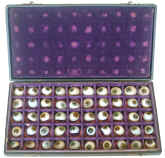
ALEX PECK MEDICAL AND SURGICAL ANTIQUES ARCHIVES
All pictures and text on this site are copyrighted ©1982-2025 Alex Peck. All rights reserved.
A boxed-set of 50 c. 1880 antique prosthetic glass eyes. Each handmade artificial glass eye is in superb condition. SOLD
PAGE 42
________________________________
A boxed-set of 50 c. 1880 antique prosthetic glass eyes. Each handmade artificial glass eye is in superb condition.
__________________________________________________
These two antique diagnostic percussion hammers were used by Elliott C. Cutler, M.D. (1888-1947), Mosely Professor of Surgery at Harvard Medical School. Cutler made cardiac surgery history when he was the first to operate successfully upon a human heart valve in 1923. He followed Harvey Cushing as surgeon-in-chief at Brigham in 1932. Cutler held the post of chief surgical consultant to the military in the European Theater during World War II. The top instrument is known as Curschmann's, and it has ivorine scales on the handle. At the bottom is Niemayer's percussor, and it has an ebony handle.
_______________________________________________
A hand-colored facsimile drawing of an Ottoman Turk female showing circulatory, reproductive, and urinary systems. The full-frontal pose goes back to at least the Middle Ages.
___________________________________________
An antique monaural stethoscope made of hard rubber. The ear-plate is exceptional large with a diameter of 7 cm. A nearly identical instrument, named Todd's stethoscope, is illustrated in Weiss 1860 , pl. XLII, fig. 17. Weiss says, The only peculiarity of this instrument is its very slender stem, and large ear-plate.
______________________________________________
A c. 1840 antique medicine chest with attached plaque inscribed: John C. Warren / Surgeon / Park St. Boston. For background information on the great Harvard anatomist, surgeon, and pioneer in anesthesiology, John Collins Warren, M.D. (1778-1856), please click here. Warren's residence was at 2 Park Street, Boston. Provenance: John Collins Warren, M.D.; then, upon his death, to J. Sullivan Warren, M.D., his son; on Sullivan's death, in 1867, to his nephew, James Dwight; the estate of Richard Dwight, M.D.
_________________________________________
A rare type c. 1820 English antique bloodletting spring lancet with original barrel-shaped case. The blade depth is adjusted by turning the large conical nut to the rear and it is cocked by pulling on the nut. A lever trigger to fire the blade is to the side of the lancet. The brass retains its handsome lacquer finish.
____________________________________________
An 18th century Jewish izmel (circumcision knife) with faceted agate handle, scalloped silver ferule, and double-edged blade. The agate handle may be a vestige of the all-stone izmel of antiquity. Click here to see three all-stone circumcision knives.
___________________________________________
A c. 1800 brass multi-bladed brass scarificator marked F.D. Wien and engraved with two bleeding cups. The antique bloodletting scarificator is a square as is the Viennese custom.
______________________________________
A c. 1780 antique amputation saw with a handsomely carved grip. The instrument has the crown and star mark of the English surgical instrument maker James Stodart (1760-1823). Stodart, a Fellow of the Royal Society, was considered a leading metallurgist of his day and worked with the chemist Sir Humphrey Davy and the physicist Michael Faraday. The blade is tightened by using the spanner as illustrated. This 18th century amputation saw is a classic type for the period of the American Revolution. To have a matching spanner is a rare plus.
_________________________________________________
A selection of mid- 20th century stethoscopes. From the bottom-up: a c. 1940 English binaural; a c. 1950 binaural by Allen & Hanburys, London; a c. 1960 Bowles' by Pilling, Philadelphia, with original box.
_____________________________________________
A c. 1900 antique chloroform drop bottle by Maw, Son and Thompson, London. The glass is graduated for volume. This anesthesia antique dropper has its original screw-on cap and leather protective case.
_______________________________________________
A c. 1880 paper-wrapped glass bottle with handwritten label: Anaesthesia for / Inhlation for / Children / Be careful [sic]. This is a quaint antique anesthesia artifact.
_______________________________
A set of antique veterinary instruments with case marked: INST[RUMET]s VÉTÉRINAIRES / BOURDIN / Place Du Change / LYON. The instruments, some with horn handles, include a bloodletting fleam, a counter-irritation seton needle, a vaccinating lancet, hoof cleaning and cutting knives, scalpels, a director, etc.
______________________________________________________
A scarce and fine c. 1880 temple (small size) brass scarificator by Evans, London. The instrument was made to be used in size-restricted areas, such as the temple, and upon children. Note that it has only four blades, as opposed to the standard-sized 10 to 12 bladed scarificators. This antique bloodletting instrument retains its original decorative squiggle-design surface and protective lacquer finish.
___________________________________________
Page 42
1. 2. 3. 4. 5. 6. 7. 8. 9. 10. 11. 12. 13. 14. 15. 16. 17. 18. 19. 20. 21. 22. 23. 24. 25. 26. 27. 28. 29. 30. 31. 32. 33. 34. 35. 36. 37. 38. 39. 40. 41. 42. 43. 44. 45. 46. 47. 48. 49. 50. 51. 52. 53. 54. 55. 56. 57. 58. 59. 60. 61. 62. 63. 64. 65.
Home Page Collecting Alerts Reference Books Wants